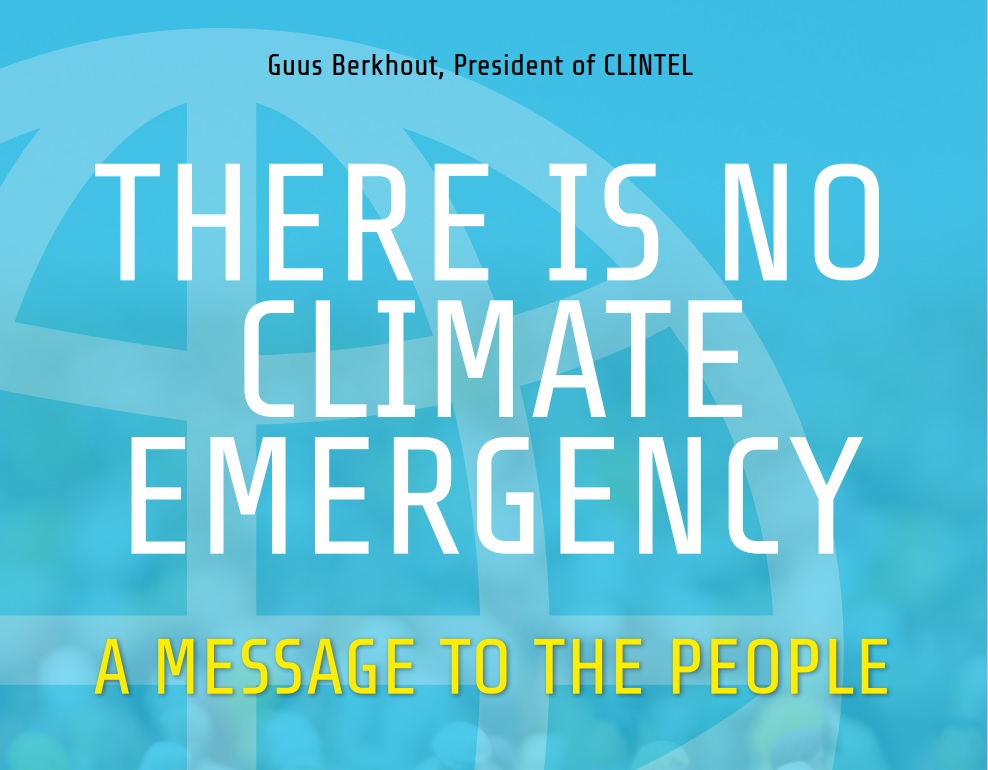
There is No Climate Emergency,
a Message to the People
See pdf here
Guus Berkhout, President of Clintel
In the past decades the public has been flooded with fear-mongering stories, telling them that global temperatures will rise to catastrophically high levels.
Climate activists claim that the cause of all this impending doom is the increasing amount of CO2 produced by human activities. The proposed solution is the so-called net-zero emission policy, aimed at lowering human net CO2-emissions to the levels of the pre-industrial era of the late 1700s.
Those activists also claim that people should panic, and that time is running out: “Be aware that it is five minutes to midnight, we must act without delay!” Many thousands of scientists disagree;
Already
1992
are Clintel signatories.
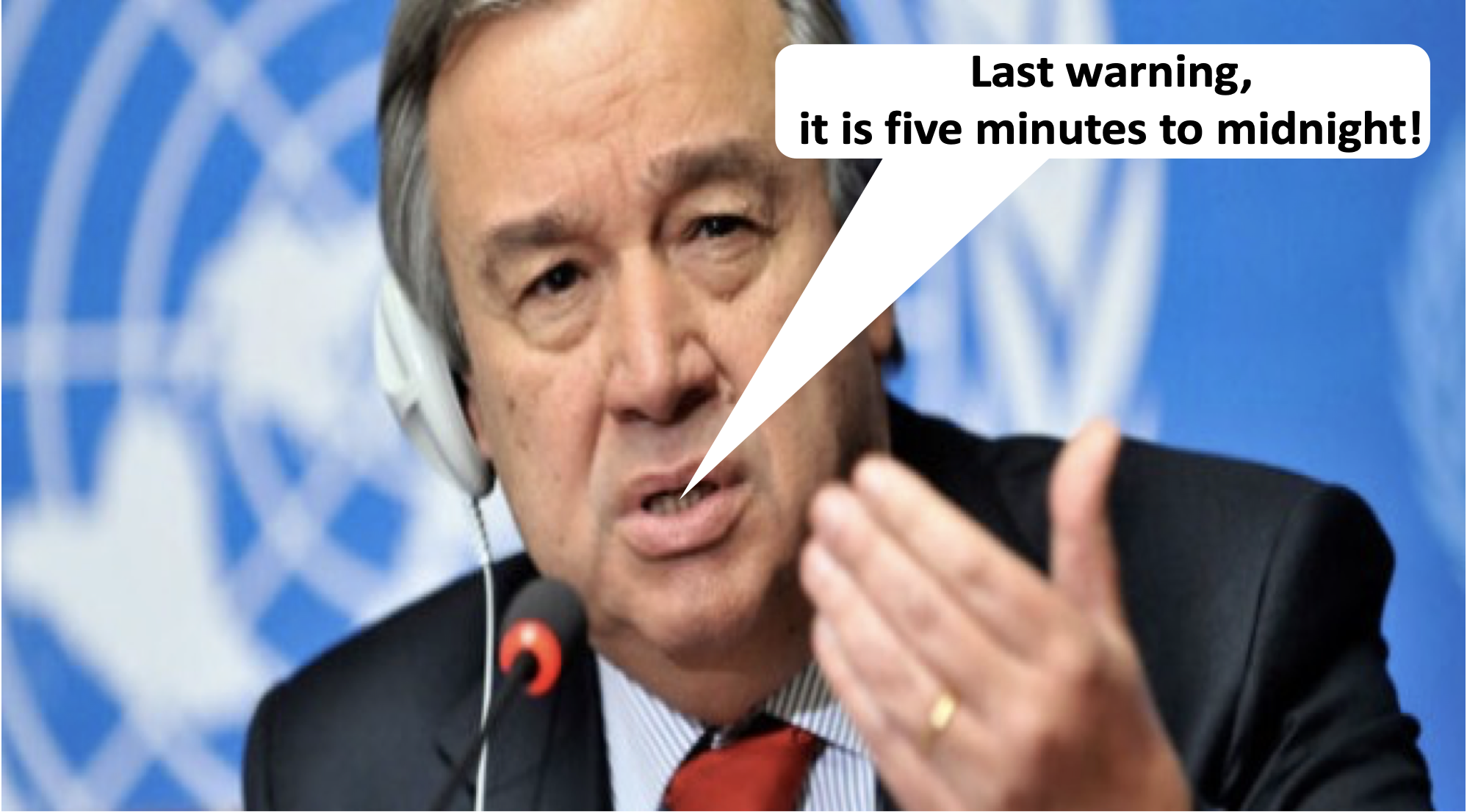
Antonio Guterres, big boss of the UN
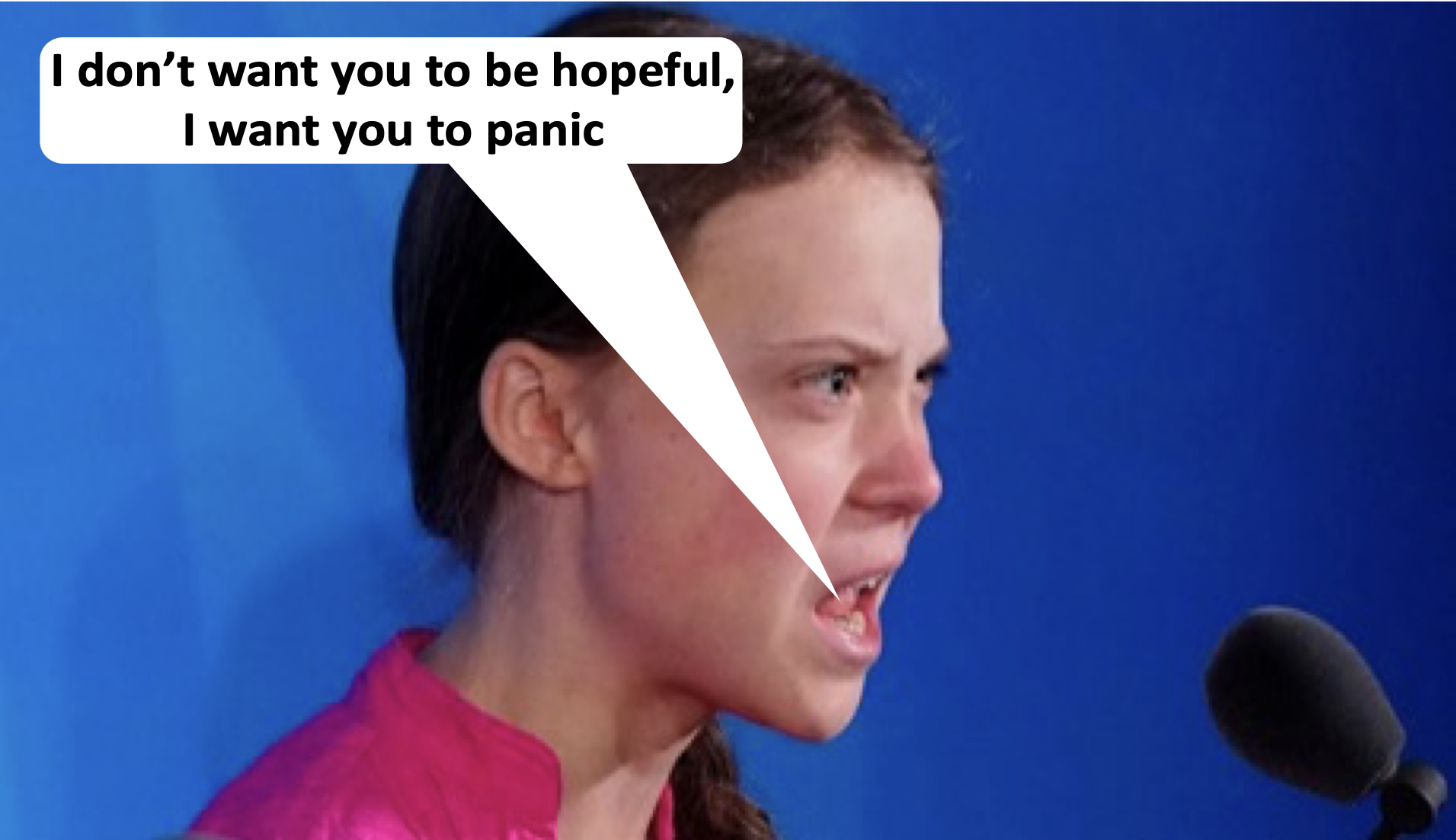
Greta Thunberg, teen climate activist
In his numerous ‘last warning’ speeches, Antonio Guterres refers to computer simulations, not the real world. Greta Thunberg testified to the US Congress that there was ‘no science’ behind her ‘panic’ comment. This info cannot be found in the media.
So why is there such a big difference between the scaring climate activists’ narrative and the optimistic climate scientists’ message, who believe there is no climate emergency? Please, before you continue reading, watch our message: Consensus meet CLINTEL
Not many citizens are aware that all the frightening climate predictions have been generated by computer models. And we know from experience in many other complex areas, how misleading computer models can be.
For example, think of the many wrong predictions by economic models or think of the large mistakes in recent pandemic modeling. The output of computer models depends fully on the assumptions that modelmakers put into them. In the past 50 years, the predictions of climate models about global warming and their dire effects have all been wrong. In the engineering community, they would be qualified as useless.
More specifically, the assumptions in climate modeling are such that predicted temperature changes turn out to be persistently too high. Even worse, extreme weather events – such as heatwaves, droughts, floods, hurricanes etc. – are intentionally used to support the extreme climate predictions. But if we position the current extreme weather events in a historical context, we see that these events are ‘climate business as usual’. See Goklany, 2020.
The conclusion is that models (computer simulations) run ‘too hot’ and that predictions of adverse effects on humans are highly dubious. They project a catastrophic future that is not born out by observations. It is much wiser and safer to rely on measurements. The history of science tells us that significant steps forward are always fueled by observations from new measurement instruments.
Think of the very recent spectacular images of outer space by the new James Webb Space Telescope. The same good news applies to the modern satellites that deliver high-quality measurements around the Earth since 1979. Satellite data shows NO extreme warming, and this is cross-checked by millions of weather balloon measurements.
Therefore, let us make use of the abundant temperature measurements made through the years. Those from the beginning of the industrial period (1850) until the present (2020) we see in Figure 1. Measurements tell us that the temperature in 2020 is 1.1 oC higher than in 1850.
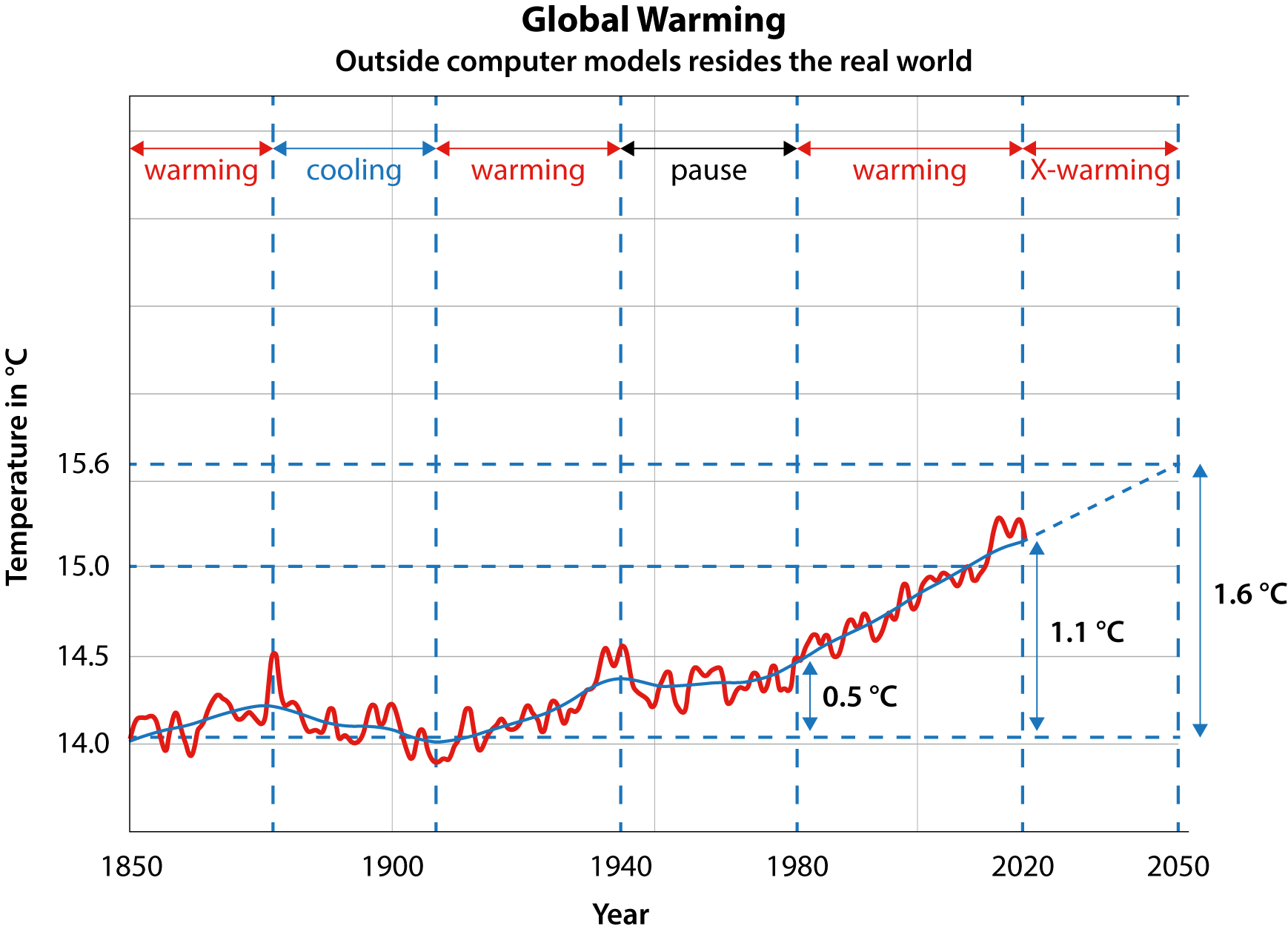
Figure 1: Global temperature curve as currently generally accepted from 1850-2020. If we extend the measurements to 2050, we see that the temperature is 1.6 oC higher than in 1850 (‘X-warming’).
Using Figure 1, let us extrapolate the satellite temperatures to the year 2050 by assuming that the temperature increase of the past 40 years (1980-2020) will carry on without any pausing and cooling. This generous projection results in a 2050-temperature that is 1.6oC higher than in 1850. Now, here is the big question: ‘Is the global warming of 1.6oC a scary result? Does this outcome really tell us that it is ‘five minutes to midnight’?
Let us look at today’s difference in mean temperature between Oslo (one of the big cities near the North Pole) and Singapore (one of the big cities near the Equator), see Figure 2. Measurements show that the difference is as much as 22oC, twenty times bigger than the global warming between 1850 and 2020 and almost 14 times bigger than the so-called ‘scary’ global warming between 1850 and 2050.
Despite of this huge mean temperature difference of 22oC, both cities are very prosperous and the citizens in both cities are enjoying life. So, why do the media tell us that a global warming of 1.6oC or more will lead to a disaster (“the end is near”), while 22oC difference between Oslo and Singapore turns out to be no problem whatsoever?
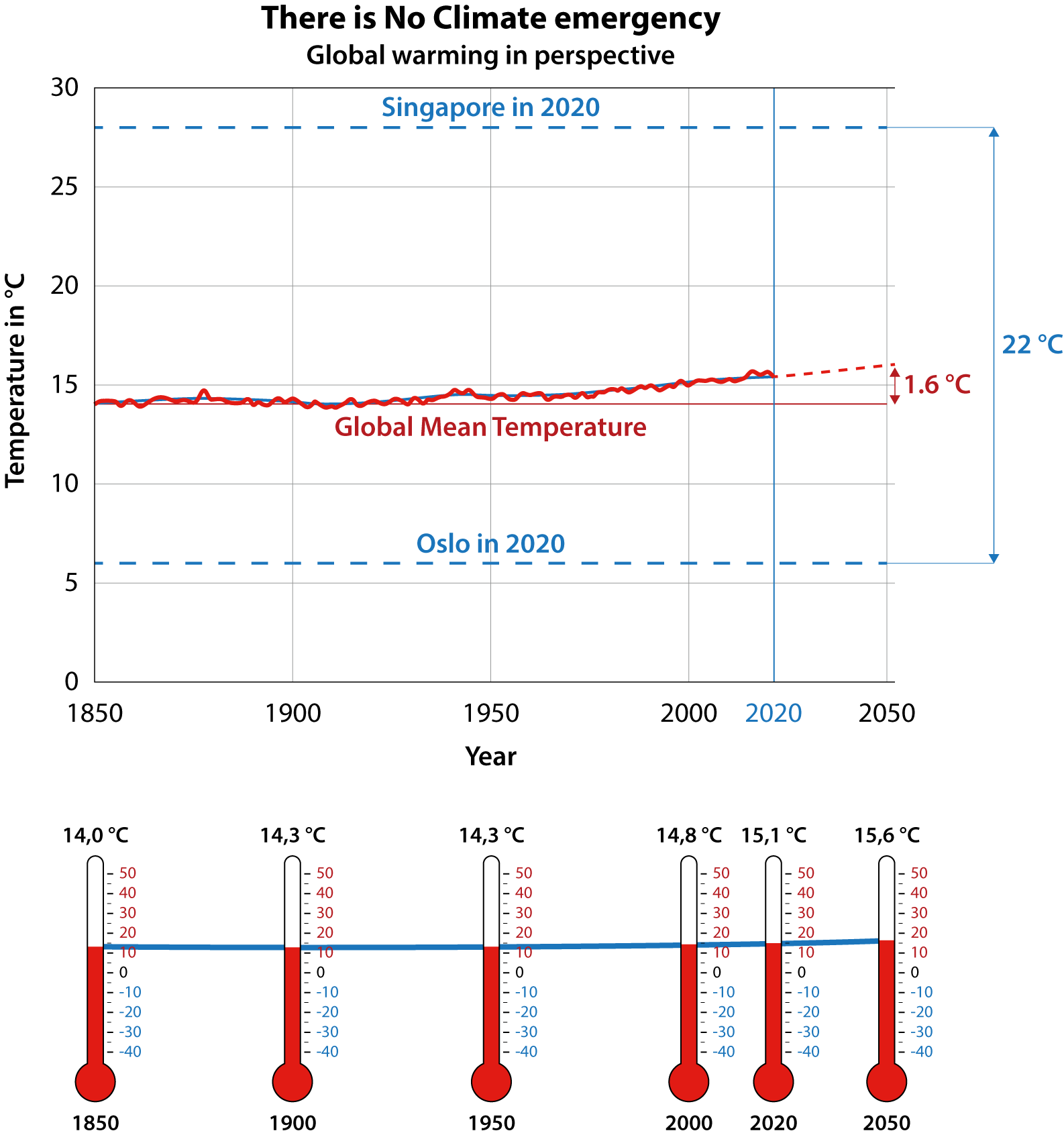
Figure 2: Global mean temperature from 1850-2050, together with the average temperature of the prospering cities Oslo and Singapore in 2020. Note that the global warming of 1.6 °C is marginal with respect to the difference of 22 °C between the two cities (almost factor 14)
The answer is adaptation! Mankind shows an impressive history, having survived many big changes in its living environment, including big changes in the Earth’s climate. Thanks to our ingenuity, human beings have always found clever solutions to cope with all past challenges, again and again. If you visit Oslo and Singapore, you see an impressive demonstration of human’s capability to adapt to climate differences of 22oC.
There is another interesting observation to make. Gradual global warming is not a serious problem, whether it is caused by CO2 or not. Not mitigation but adaptation is the solution. So, for all of those who would like to think that the present global warming is fully caused by CO2, our conclusion stays unchanged.
Bear in mind that during the cooling period around 1900 and the temperature pause in the sixties (see Figure 1), the CO2-concentration in the atmosphere continued to increase without delay. Hence, the anomalous temperature behavior in these two periods were indisputably caused by mother nature. The same applies for the large climate difference between Oslo and Singapore.
Finally, for those who still believe that CO2-emissions are pollution, we urge you to remember that CO2 is essential for all life on Earth. Additional CO2 in the air has promoted growth in global biomass. It is also very favorable for agriculture, increasing crop yields worldwide.
If also this fact of life isn’t sufficiently convincing, please realize that with the availability of modern nuclear power plants we have ample time to create a global energy system with largely zero emission. But again, the big question is whether zero emission is a sensible goal.
In conclusion, don’t let the terrifying stories of supranational institutions – such as the UN, EU and WEF – scare you. Particularly, climate alarmists must not use extreme weather events to poison our children with fear:
The gradual global warming, which started around 1700 after the end of the Little Ice Age, is a fact and has not caused any serious problem. Our advice is: “Enjoy today’s climate, because stories from the Little Ice Age tell us that a cold climate is full of hardship”.
If we continue to invest in innovation, mankind can easily cope with any effect of further warming. Hence, we must stop the demoralizing back-to-the-past mitigation solutions. We observe that it only leads to decline and poverty.
Instead, we must focus on the power of adaptation, based on science, technology, and education. It will lead us into an era of prosperity for nature and mankind. Please, join our journey!


Climate related deaths (floods, droughts, storms, wildfires, extreme temperatures) have declined precipitously because richer and more resilient societies reduce disaster deaths and swamp any potential climate signal.
Thirty years of climate summits have had no discernible effect on the rise in atmospheric CO2 concentration. These summits cost an enormous amount of money. Money which can be better spent on adaptation measures.
Guus Berkhout is emeritus-professor of geophysics, member of the Royal Netherlands Academy of Arts and Sciences (KNAW)

SUPPORTERS WCD
1. Mario Marquinez Otálora, Argentina
2. Emma Carlone, Australia
3. Tim Davidson, Australia
4. Craig Davis, Australia
5. Andrew Graddon, Australia
6. David Graham, Australia
7. Clemens Grieger, Australia
8. Anthony Grigor-Scott, Australia
9. Paul Hamilton, Australia
10. Alan Kennett, Australia
11. Nicholas Loades, Australia
12. James Longfield, Australia
13. Nuraini Magnusson, Australia
14. Matthew Moyes, Australia
15. Patrick O’Meley, Australia
16. Tom Polich, Australia
17. Ian Storey, Australia
18. Lynette Sunderland, Australia
19. Ingvar Warnholtz, Australia
20. Gerhard Ing. Lassnig, Austria
21. Karin E.J. Kolland, Austria
22. Franz Promock, Austria
23. Sebastien Calebout, Belgium
24. Bart Decroix, Belgium
25. Jelle D’Helft, Belgium
26. Mieke Franquet, Belgium
27. Luc Pintens, Belgium
28. João de Sousa Luz, Brazil
29. Aldo Fabre, Brazil
30. Francisco Mendes Moraes, Brazil
31. Marcelo Nepomuceno Carius, Brazil
32. Leif Andersen, Canada
33. Darren Becker, Canada
34. Patricia Bowman, Canada
35. Ivanna Broesky, Canada
36. Robert Daye, Canada
37. Wade Doucette, Canada
38. Inge Hanle, Canada
39. Craig Horner, Canada
40. Dwight Jones, Canada
41. Leslie Keighan, Canada
42. Kerstin Kelly, Canada
43. Stephan Larsson, Canada
44. Al Majauskas, Canada
45. Howard Phelan, Canada
46. Derwyn Ross, Canada
47. Florentina Silianu, Canada
48. Dr Howard Tenenbaum, Canada
49. Lyndon Trombley, Canada
50. Greg Urton, Canada
51. Alex Abumohor, Chile
52. Enrique Casanovas, Chile
53. René Hurtado, Chile
54. David Paterson, China
55. Jonothan Keir Sims, China
56. Andreas Christodoulides, Cyprus
57. Charles Hope, Cyprus
58. Michal Bílý, Czech Republic
59. PhDr. Leo Cuda, Czech Republic
60. Radek Kveton, Czech Republic
61. Daniel Markvart, Czech Republic
62. Jiri Strachota, Czech Republic
63. Kaspar Bonde Eriksen, Denmark
64. Hugh Sharman, Denmark
65. Juhani Anttila, Finland
66. JOSEPH Alain, France
67. Ricol Fabien, France
68. Pascal Frèches, France
69. Natasha O Shaughnessy, France
70. Lucien Oulahbib, France
71. Peter Taylor, France
72. Noirtault Thierry, France
73. Achim Benoit, Germany
74. Christian Bickeböller, Germany
75. Wilfried Boysen, Germany
76. José de la Iglesia, Germany
77. Nikolai Dick, Germany
78. Adelbert Herzog, Germany
79. Christopher Hesse, Germany
80. Bernhard Kleinhenz, Germany
81. Lynda Matschke, Germany
82. Kiana Meier-Friedhoff, Germany
83. Manfred Patzwahl, Germany
84. Rafael Sterzer, Germany
85. Christoph Wallner, Germany
86. Lutz Weber, Germany
87. Michael Wegener, Germany
88. Christian Ziep, Germany
89. George Zikos, Greece
90. Bence Gabor Peter, Hungary
91. Pandu Wisaksono, Indonesia
92. Roger Eldridge, Ireland
93. Terry O Sullivan, Ireland
94. Rabbi Gabriel Cousens MD, Israel
95. Antonio Bettanini, Italy
96. Giorgio Caprile, Italy
97. Massimiliano Diodati, Italy
98. Laura Fanfani, Italy
99. Claudio Antonio Lucchesi, Italy
100. Graziano Murru, Italy
101. Mario Natalucci, Italy
102. Maria Psalidi, Italy
103. Domenico Salimbeni, Italy
104. Maurizio Tambani, Italy
105. Gino Attilio Timo, Italy
106. Vincenzo Trainito, Italy
107. Giancarlo Troiani, Italy
108. Giorgio Vismara, Italy
109. Mikhail Boreyko, Kazakhstan
110. Carlo Besenius, Luxembourg
111. Paul Andersson, Netherlands
112. Ado Bloemendal, Netherlands
113. Paul Claes, Netherlands
114. Willem Hageman, Netherlands
115. Rene Houthoff, Netherlands
116. Dick Kraaijenbrink, Netherlands
117. Konstantinos Letsios, Netherlands
118. Paul Markus, Netherlands
119. Tom Pieterse, Netherlands
120. Sandro Stoffers, Netherlands
121. Peter Venema, Netherlands
122. Duncan Christie, New Zealand
123. Bruce C Collings, New Zealand
124. Jesper Siegfried Enerstvedt, Norway
125. Nina Jonsson, Norway
126. Vivi-Ann Sandnes, Norway
127. Haavard Skjaervik, Norway
128. Svein Olav Stormark, Norway
129. Juan Lazo, Peru
130. Jose Tapia, Peru
131. Alain Charles Veloso, Philippines
132. Pablo de la Fuente de Pablo, Poland
133. Szymon Głąbski, Poland
134. Marek Langalis, Poland
135. Rui Abreu, Portugal
136. Flavio Barbara, Portugal
137. Alexander Rodriguez, Singapore
138. Milos Dian, Slovakia
139. Milan Gábor, Slovakia
140. Lore-lei Cerqueira, South Africa
141. Jan Tredoux, South Africa
142. Leopoldo Abadia, Spain
143. Manuel Espejo, Spain
144. José María Fernandez-Bravo Álvarez, Spain
145. Luis Garcia, Spain
146. jose Ignacio garcia Bielsa, Spain
147. José Ignacio Herreras Espinosa, Spain
148. Antonio Lista, Spain
149. Jorge López Pollo, Spain
150. Javier Miguel Gonzalez, Spain
151. Luis Muñoz, Spain
152. Vicente Nomdedeu, Spain
153. Gert-jan Mathijs Oepkes, Spain
154. Ricardo Pascual Iglesias, Spain
155. Pedro Reche, Spain
156. Elena Simó, Spain
157. Inge Bjart Torkildsen, Spain
158. Carlos Urrutia Nebreda, Spain
159. Zhamuel Boij, Sweden
160. Erika Brandt, Sweden
161. Lars-Olof Ödlund, Sweden
162. Leif Ringhagen, Sweden
163. Mikael Wollnäs, Sweden
164. Janos Vrbata, Switzerland
165. Peter Pop, United Arab Emirates
166. Gordon Ballantyne, United Kingdom
167. Keith Brown, United Kingdom
168. Kevan Chippindall-Higgin, United Kingdom
169. Aidan Condie, United Kingdom
170. Robert DABLE, United Kingdom
171. Eugene Daniel, United Kingdom
172. Michael Davies, United Kingdom
173. Ruth Ferguson, United Kingdom
174. Patrick Fossett, United Kingdom
175. David John Fraser, United Kingdom
176. Michael Gilding, United Kingdom
177. Roland Gilmore, United Kingdom
178. Kenneth Gorman, United Kingdom
179. Solomon Green, United Kingdom
180. William Hawkins, United Kingdom
181. Martin Haywood-Samuel, United Kingdom
182. Robert Heath, United Kingdom
183. John Howes, United Kingdom
184. Toni Ives, United Kingdom
185. Bryan Johnston, United Kingdom
186. David Johnstone, United Kingdom
187. Bethany Jukes, United Kingdom
188. Joseph Kavanagh, United Kingdom
189. Howard Koolman, United Kingdom
190. Nigel Lawrence, United Kingdom
191. Andrew Mackay, United Kingdom
192. Richard Maguire, United Kingdom
193. David Martin, United Kingdom
194. Stuart McCarthy, United Kingdom
195. Gerrard Mccluskey, United Kingdom
196. Stephen J. Medlock, United Kingdom
197. Hilary Muggridge, United Kingdom
198. Robert Nellist, United Kingdom
199. Morkel Otto, United Kingdom
200. Andrea Pearson, United Kingdom
201. Robert Peddar-Adams, United Kingdom
202. Stephen Peliza, United Kingdom
203. Vela Rasarathnam, United Kingdom
204. Yvonne Ross, United Kingdom
205. Leo Rutherford, United Kingdom
206. Catherine Shipley, United Kingdom
207. Nick Stedman, United Kingdom
208. Angie Stone, United Kingdom
209. Charles Tannett, United Kingdom
210. Desmond Thompson, United Kingdom
211. Ian Travers, United Kingdom
212. Jack Turnbull, United Kingdom
213. Andrew Verdon, United Kingdom
214. Richard Ward, United Kingdom
215. Neil Wilkes, United Kingdom
216. D. Williams, United Kingdom
217. Nigel Wilson, United Kingdom
218. Greg Abell, United States of America
219. Dr. James Aldrich, United States of America
220. Paul Allyn, United States of America
221. E Scott Argento, United States of America
222. Roger Ayotte, United States of America
223. Michele Baxter, United States of America
224. Richard Bay, United States of America
225. Carl Beels, United States of America
226. Charles Bellavia, United States of America
227. Thomas Bingel, United States of America
228. Mark Brody, United States of America
229. Robert Broe, United States of America
230. Sue A. Brown, United States of America
231. Craig Brueckman, United States of America
232. Janice Bryson, United States of America
233. Kevin Burger, United States of America
234. John Byrne, United States of America
235. Jeff Campbell, United States of America
236. Joseph Chiaro, United States of America
237. David Cornberg, United States of America
238. Pamela Cornelius, United States of America
239. Charley Cropley, United States of America
240. Espen Dahlen, United States of America
241. Jeff Davison, United States of America
242. Grant Dixon, United States of America
243. John Doleman, United States of America
244. William Dondarski, United States of America
245. Benn Dover, United States of America
246. Vincent A. Ettari, United States of America
247. David Fair, United States of America
248. Jonathan Frishberg, United States of America
249. Bernardo Garza, United States of America
250. Christine Goodwin, United States of America
251. Robert Gorgone, United States of America
252. Gio Batta Gori, United States of America
253. Shelley Graham, United States of America
254. Donny Griffin, United States of America
255. Herbert Guenther, United States of America
256. Frans Hager, United States of America
257. John Halbur, United States of America
258. Curt Hanson, United States of America
259. Michael Hartman, United States of America
260. Harvey Hnatiuk, United States of America
261. David Houghland MD, United States of America
262. David Jaskierny, United States of America
263. Michael Jones, United States of America
264. Timothy Kearney, United States of America
265. Marvin Langston, United States of America
266. Stephen Larbig, United States of America
267. Ted Laskaris, United States of America
268. Robert R. Lerma, United States of America
269. John Lovett, United States of America
270. Robert McCarter, United States of America
271. James McGough, United States of America
272. Linda Mckenzie, United States of America
273. Aaron McKissack, United States of America
274. George Mcleod, United States of America
275. Geoffrey McNiven, United States of America
276. Pamela Mcvicar, United States of America
277. Jim Medlar, United States of America
278. Ed Meyer, United States of America
279. William Moye, United States of America
280. Maurice Murphy, United States of America
281. Kimon Nicolaides, United States of America
282. Arnold Nordeng, United States of America
283. Naomi Nye, United States of America
284. Jeffery Osborn, United States of America
285. Judith Osterman, United States of America
286. John Pearrow, United States of America
287. Bernard Raad, United States of America
288. Phyllis Rampulla, United States of America
289. Miriano “Max” Ravazzolo, United States of America
290. James Rice, United States of America
291. Anita Roche, United States of America
292. Al Rogers, United States of America
293. Charles G. Sandell DMD, United States of America
294. Ed Sebesta, United States of America
295. Marina Shea, United States of America
296. Roy Shockey, United States of America
297. Deborah Simpkins, United States of America
298. Christopher Snyder, United States of America
299. James Spence MD FACP FCCP, United States of America
300. Richard F. Storm, United States of America
301. Tatiana Sugar, United States of America
302. Doug Swartout, United States of America
303. Ronald Tarbutton, United States of America
304. Don Thompson, United States of America
305. Jeffrey Tschida, United States of America
306. Peter Ulasien, United States of America
307. Ronald Ulrich, United States of America
308. Russell Vogel, United States of America
309. Gary L. Wade, United States of America
310. James Waldo, United States of America
311. Glenn Weckel, United States of America
312. William Wharton, United States of America
313. Stacy Wick, United States of America
314. James Williams, United States of America
315. James Colin Wright, United States of America
